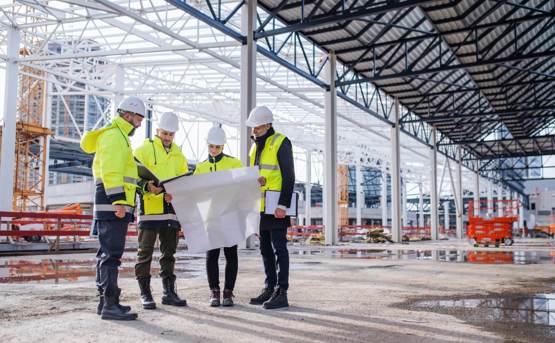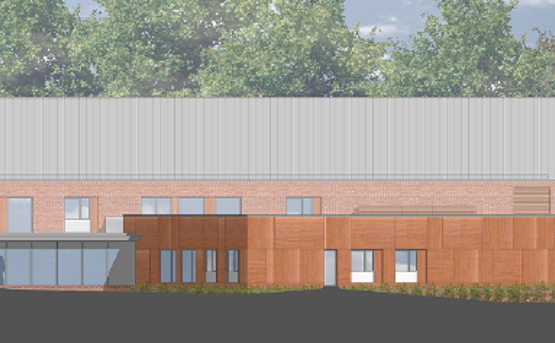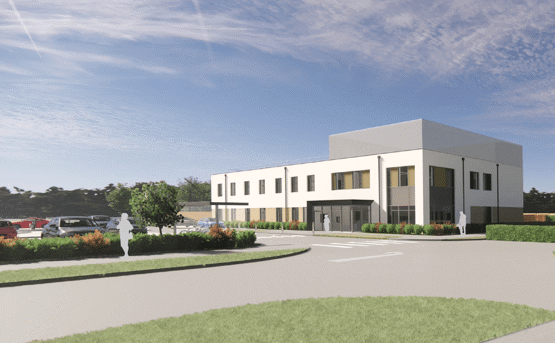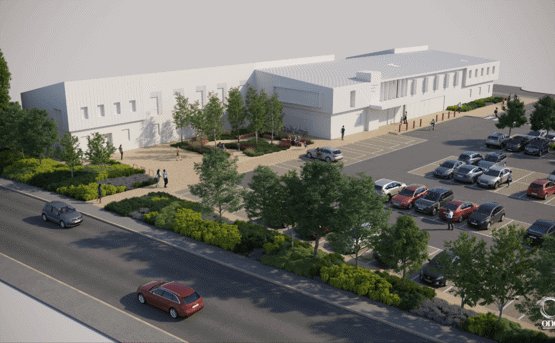
Published date: 14 September 2020
Staying Agile and Flexible in the Face of New Challenges
Adrian Powell, our Head of Property Development, speaks to the Health Estates Journal on how the NHS estate has adapted during COVID-19, and how we hope to further optimise and future-proof it.
The original article was published in The Health Estates Journal (HEJ), you can read it here.
In this ‘question and answer’-style article, Adrian Powell, head of Property Development at NHS Property Services, discusses future NHSPS and wider NHS estates optimisation strategy ‘post-COVID-19’ with HEJ editor, Jonathan Baillie.
Jonathan Baillie (JB): “What have been some of the biggest impacts and challenges for NHSPS in managing its various properties during the COVID-19 crisis?”
Adrian Powell (AP): “This is not unique to NHSPS, but, as you can imagine, among the challenges we’ve faced has been the lack of face-to-face contact and the ability to be mobile and visit sites. This is particularly true for properties that needed extra capacity during the crisis, or facilities planned for renovation/expansion and needing local planning authorities involved. It was a challenge at first, but I feel we’ve found ways to overcome this, and have continued to support our customers and their needs. By way of example, where we and local planning authorities were unable to meet, both parties have been able to adapt to meetings online, and have run digital public consultations.
“As previously mentioned, this is not a challenge unique to our organisation. Indeed, our customers and stakeholders face the same challenges. The key has been to maintain momentum and continue on with ‘business as usual’ where possible. Digital solutions have helped to support us through the COVID-19 pandemic. Our ability to transition into remote working has been a huge advantage, enabling us to continue to deliver to a high standard to support the NHS during this time, while ensuring that patients can still access the care they need – whether that’s now, or in the future.
Allied to the innovations in digital communications is the willingness from all of us to flexibly engage with the technology. There’s been a real cultural shift in how we work.
Ensuring GP access
“One of the other challenges NHSPS has faced has been ensuring that people across England could access their GP or healthcare facility for non-COVID related issues. Sadly, patients still break their legs, have heart attacks, and other ailments. They require their NHS to be able to treat them regardless of a pandemic. A collaborative approach with NHS England and colleagues throughout the country was essential in order for us to be flexible and agile in the way the estate delivers these services, particularly for those self-isolating or with long-term illnesses. Our work with NHS England has been key to providing use of vacant space and extended facilities management services where required, addressing 350 additional space requests from our customers during this time.”
JB: “How quickly did you have to put together your NHSPS COVID-19 Modular Building Guide, and how much of a part to play have rapidly constructed/erected modular buildings actually had during the COVID-19 crisis?”
AP: “We proactively developed the NHSPS Covid-19 Modular Building Guidance Document in March, with it being issued in April, near the start of the COVID-19 pandemic. As soon as it became apparent that there was going to be a capacity issue, and it was likely we would have to mobilise to create additional capacity, we wanted to develop guidance and solutions for our customers. To do this, we had to look at what space we already had available for conversion, and what we had to build new; we developed a dedicated workstream for this.
After recommissioning and/or reconfiguring vacant or underused space across our estate, the next challenge was how we could add structures quickly – quicker than the traditional construction delivery route. Modular buildings were an obvious choice, due to their quicker lead in time and delivery, and, as it turned out, the relaxation in town planning requirements alongside the extension of permitted development rights to include them.
Real-life application examples
“We issued the first version of the modular guidance note in April, and then began to expand it as we assessed our portfolio in London to provide real-life application examples for our customers. This revised version was able to demonstrate how modular buildings could accommodate more patients, at what density, and any layout or configuration issues this would give rise to. This helped to ensure that we could give people more confidence around configuration, adaptability, site requirements, cost, and lead times
Due to a large uptake in estate conversions of unused spaces, there hasn’t yet been large-scale uptake of modular structures. However, we see this as a solution going forward as we enter a ‘new normal’.”
JB: “Following on from the last question, what type of healthcare facilities have had to be constructed in modular form during the COVID-19 outbreak?”
AP: “Within our guidance we have included several examples of the types of facilities or structures available – from temporary GP surgeries, to standard wards, to shower blocks or changing facilities.
As we have all seen, Trusts and other NHS organisations have been converting previously unused space into COVID-19 wards or testing facilities. As we begin stepping down from this, modular buildings are a viable solution to ensuring that both capacity, and social distancing guidelines, are met.
Separating different patient types
“One of the ways we see modular buildings being most useful is in terms of separation of different types of patients within hospitals; for example, COVID- 19- specific ‘hot’ and ‘cold’ areas that will allow the separation of patients requiring treatment for COVID-19 vs those not presenting symptoms and requiring other medical care. We also need to consider that when business goes back to ‘normal’, the NHS will have many procedures returning, such as elective surgery, and treatments requiring overnight hospital stays. This is where we see modular construction becoming an important option for additional space.
“We will also continue to require space to test potential COVID-19 cases, and ensure that contamination does not spread throughout healthcare facilities. Examples of temporary facilities could include sanitisation stations outside hospitals for visitor use prior to entering, or screening stations for patients before they go into the hospital. These additional COVID-19 facilities will hopefully not be required long-term, which makes modular buildings a perfect temporary solution as we work towards identifying the long-term impacts on facilities from this pandemic.”
JB: “How much of a role do you see for modular buildings in the future in ensuring that the NHSPS estate is properly provisioned, and for what type of healthcare facilities do you anticipate them being most widely deployed?”
AP: “Firstly, it’s important to differentiate between temporary modular buildings and permanent buildings delivered through modern methods of construction, including onsite manufacture. There are discussions within our organisation around modern methods of construction, whereby specialist buildings or office style structures are prefabricated onsite and then assembled on location. These are not the same as temporary modular buildings, which are flexible structures assembled on site and intended to be occupied for a short period (1-2 years). The relaxation in town planning requirements, alongside the extension of permitted development rights, means modular buildings also do not always require the typical planning approvals and process. In light of this, modular buildings are important – particularly during this time – to build short-term addition to capacity or to separate services within the community.
“Often in constrained sites, we need to move existing clinical operations into temporary buildings to allow the redevelopment of main facilities. What this means is that, as well as for short-term capacity support, such as during the COVID-19 pandemic, modular buildings can also be used in place of a main building while the site is being redeveloped."
An onsite ‘decant’
“A great example of where modular building can be applied beyond COVID-19 would be for an on-site decant during a big build or redevelopment project. We are currently delivering a complete rebuild of a health centre in Chiswick, where fortunately we have a nearby vacant building we can repurpose as a decant for services. However, for other future projects we could explore the potential of transferring services into a modular building on the site itself while we redevelop the main building, negating the need to find and repurpose any nearby accommodation, and reducing upheaval for patients and staff.
“We also need to consider that, despite these being temporary structures, lead times can vary. When people think of modular buildings, they assume they can be supplied in a week or two, which simply isn’t the case. Although much quicker than traditional building works, in reality they can take 12-16 weeks to develop, plan, and build.
“We are already actively thinking about and speaking to our customers about these solutions to ensure adequate turnaround time for their needs. We are thus working with customers to ensure we receive requests ahead of any potential second wave or long-term needs. We want to be as prepared as possible to make the most efficient use of our spaces, and to help as many patients as possible, should this be necessary.”
JB: “Have a number of NHSPS schemes for new healthcare facilities had to be stopped temporarily during the coronavirus outbreak, and, where this has not been necessary, how has construction been managed? How significant a financial impact could having to halt some construction of new facilities / refurbishment have?”
AP: Many of our projects have been able to continue thanks to the flexibility of the local authorities during the pandemic. Devizes and Trowbridge, for example, are two great examples of applications that our town planning team have been running for new integrated healthcare centres We have been working in partnership with Bath, Swindon and Wiltshire (BSW) Clinical Commissioning Group (CCG), and other key stakeholders, on plans for a new integrated care centre adjacent to the existing Devizes Treatment Centre.
This new facility will accommodate the services currently provided at Devizes Community Hospital, alongside significantly increased primary care capacity, out-of-hospital urgent care services, enhanced extended hours services provision, and an expanded range of other healthcare services for patients. With the hard work of our teams and the local planning authorities, we were able to find solutions to the issues that COVID-19 has posed in order to avoid delays to planning permissions and construction. Last month we submitted a ‘reserved matters’ planning application to Wiltshire Council for approval, confirming appearance, design, layout, and other details of the healthcare facility. This was important to us, as any delays would have resulted in patients being without the important services and facilities that we are pleased to be bring to the local community.
New integrated health centre
“Similarly, in Trowbridge, we have been working with Wiltshire Clinical Commissioning Group to generate plans for a new integrated health care centre on land adjacent to the existing community hospital. The proposal is for a new facility that will provide all of the services currently available at Trowbridge Community Hospital, as well as additional primary care capacity and an expanded range of other health care services. We’re delighted to have maintained our stamina during the pandemic, and trust among our customers, by remaining on track to deliver this new facility to the timeline set, submitting an outline planning application back in April.”
JB: “How much liaison has there been between the NHSPS team and local authorities over new procedures for speeding up planning permission for temporary healthcare facilities, as and when they are needed, for instance in response to a pandemic such as the one we are experiencing?”
AP: “We have worked hand in hand with local authorities to ensure a smooth, yet compliant process is carried out when developing temporary facilities, or when renovating existing space for COVID-19 capacity. We have worked with a number of local authorities who have adapted their processes to enable us to continue with our planning applications over the past few months, and have been proactively tracking and producing guidance notes on changes to town planning regulations during the pandemic. This has been important in ensuring that we continue to provide the high-quality service that is expected of us from our customers. We strive to make the most of all of the spaces that we are constructing, particularly at this time, when patients require urgent care more than ever.
“It is essential that we have time to ensure that buildings are safe and fully prepared for occupancy. Through our work with local authorities, we have been able to help our people do a great job at ensuring these buildings are created to these standards as quickly as possible to support the NHS and its patients.”
JB: “How flexible have local authorities been in terms of adapting existing planning guidance and procedures to allow ultra-fast construction of temporary healthcare facilities?”
AP: “Modular buildings give a certain amount of flexibility, which has been recognised by the Government through the provision of COVID-related relaxations in town planning. The Ministry of Housing, Communities & Local Government has issued the planning guidance for local authorities to allow flexibility in use of property to respond to the pandemic, including for modular buildings “This flexibility has allowed for temporary emergency development to be undertaken by a local authority or health service body, enabling the creation of temporary buildings to address COVID-19 without the need to submit a planning application. These relaxations have made it easier for people to use modular or temporary buildings where required, creating a streamlined response to this crisis throughout NHS facilities, and ensuring that the required space for all patients has been made available.
Relaxing of measures
“The Government is continuing to issue relaxations to facilitate the provision of health services, but also to restart the economy. There are a number of planning relaxations that aren’t necessarily directly related to healthcare, but still would be helpful for a property company like us with 3,000 properties that we need to manage, and we are therefore proactively tracking and reporting on Government announcements and subsequent changes to town planning policy. There could be ways that we could operate our portfolio that would bring some advantage to our NHS partners – for example relaxing 'change-of-use' applications when we are preparing vacant sites for sale.”
JB: “What wider lessons do you think NHSE / NHSI and NHSPS might learn about the optimal utilisation of the NHS estate in the wake of COVID-19?”
AP: “COVID-19 has made our teams increasingly aware of the importance of understanding the space that we have available, and who is occupying it. Ensuring that space is being used in the most efficient way can enhance the healthcare services for members of the community around these spaces. While none of us could have predicted this pandemic, what it has shown is that ensuring that space is being used efficiently is instrumental to the NHS’s running – from building a clear picture of how the estate is being used, to securing funding for improvements, to implementing solutions. Ensuring we have an up-to-date and detailed record of our estate usage will be of even higher importance as we hope to move forward from this crisis, and we are proactively working with our customers to gather this information.”
JB: “How difficult – looking ahead – is it to plan medium to longer-term strategy for primary care building provision given that the pandemic has shown that remote GP consultation does ‘work’ for some patients, but that, equally, there will still always be a need for face-to-face appointments, both for practical purposes – for instance for minor procedures, and so the vital GP/patient relationship is maintained?”
AP: “COVID-19 presents a significant opportunity to review and alter clinical service strategies and models – with one element being whether GPs continue to do most of their patient consultations by video, or revert to face-to-face consultations. This is important, as it will have an impact on current properties, how they operate, and how they are configured, as well as on new or redeveloped properties planned for the next several years.
“It is our impression that while video consultations will make up a significant proportion of GP and hospital appointments moving forward, they won’t by any means fully replace face-to-face appointments. We will be working closely with our NHS partners to better understand patient and staff requirements that will shape clinical strategy, which will then unlock guidance for subsequent estate strategies. As we continue developing our understanding for how the space we currently occupy is being used, we can determine the effect it has on design, specifications, and Clinical Commissioning Groups, to ensure the best care for patients within the community.
Because of this, we must be very flexible in terms of the design proposals that we are bringing forward to local planning authorities. We must maintain momentum for the development programme, while also ensuring that it is flexible enough to meet changing clinical service requirements.”











